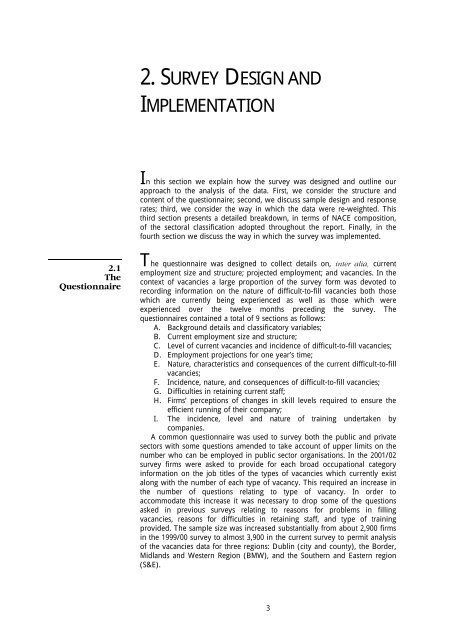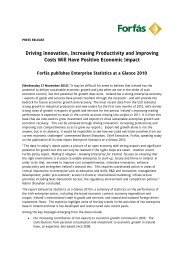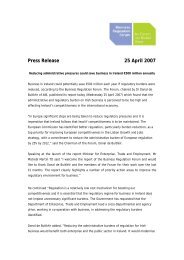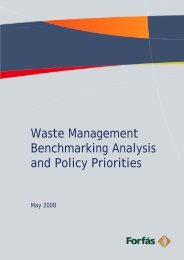National Survey of Vacancies in the Private (Non ... - Forfás
National Survey of Vacancies in the Private (Non ... - Forfás
National Survey of Vacancies in the Private (Non ... - Forfás
Create successful ePaper yourself
Turn your PDF publications into a flip-book with our unique Google optimized e-Paper software.
2.1<br />
The<br />
Questionnaire<br />
2. SURVEY DESIGN AND<br />
IMPLEMENTATION<br />
In this section we expla<strong>in</strong> how <strong>the</strong> survey was designed and outl<strong>in</strong>e our<br />
approach to <strong>the</strong> analysis <strong>of</strong> <strong>the</strong> data. First, we consider <strong>the</strong> structure and<br />
content <strong>of</strong> <strong>the</strong> questionnaire; second, we discuss sample design and response<br />
rates; third, we consider <strong>the</strong> way <strong>in</strong> which <strong>the</strong> data were re-weighted. This<br />
third section presents a detailed breakdown, <strong>in</strong> terms <strong>of</strong> NACE composition,<br />
<strong>of</strong> <strong>the</strong> sectoral classification adopted throughout <strong>the</strong> report. F<strong>in</strong>ally, <strong>in</strong> <strong>the</strong><br />
fourth section we discuss <strong>the</strong> way <strong>in</strong> which <strong>the</strong> survey was implemented.<br />
The questionnaire was designed to collect details on, <strong>in</strong>ter alia, current<br />
employment size and structure; projected employment; and vacancies. In <strong>the</strong><br />
context <strong>of</strong> vacancies a large proportion <strong>of</strong> <strong>the</strong> survey form was devoted to<br />
record<strong>in</strong>g <strong>in</strong>formation on <strong>the</strong> nature <strong>of</strong> difficult-to-fill vacancies both those<br />
which are currently be<strong>in</strong>g experienced as well as those which were<br />
experienced over <strong>the</strong> twelve months preced<strong>in</strong>g <strong>the</strong> survey. The<br />
questionnaires conta<strong>in</strong>ed a total <strong>of</strong> 9 sections as follows:<br />
A. Background details and classificatory variables;<br />
B. Current employment size and structure;<br />
C. Level <strong>of</strong> current vacancies and <strong>in</strong>cidence <strong>of</strong> difficult-to-fill vacancies;<br />
D. Employment projections for one year’s time;<br />
E. Nature, characteristics and consequences <strong>of</strong> <strong>the</strong> current difficult-to-fill<br />
vacancies;<br />
F. Incidence, nature, and consequences <strong>of</strong> difficult-to-fill vacancies;<br />
G. Difficulties <strong>in</strong> reta<strong>in</strong><strong>in</strong>g current staff;<br />
H. Firms’ perceptions <strong>of</strong> changes <strong>in</strong> skill levels required to ensure <strong>the</strong><br />
efficient runn<strong>in</strong>g <strong>of</strong> <strong>the</strong>ir company;<br />
I. The <strong>in</strong>cidence, level and nature <strong>of</strong> tra<strong>in</strong><strong>in</strong>g undertaken by<br />
companies.<br />
A common questionnaire was used to survey both <strong>the</strong> public and private<br />
sectors with some questions amended to take account <strong>of</strong> upper limits on <strong>the</strong><br />
number who can be employed <strong>in</strong> public sector organisations. In <strong>the</strong> 2001/02<br />
survey firms were asked to provide for each broad occupational category<br />
<strong>in</strong>formation on <strong>the</strong> job titles <strong>of</strong> <strong>the</strong> types <strong>of</strong> vacancies which currently exist<br />
along with <strong>the</strong> number <strong>of</strong> each type <strong>of</strong> vacancy. This required an <strong>in</strong>crease <strong>in</strong><br />
<strong>the</strong> number <strong>of</strong> questions relat<strong>in</strong>g to type <strong>of</strong> vacancy. In order to<br />
accommodate this <strong>in</strong>crease it was necessary to drop some <strong>of</strong> <strong>the</strong> questions<br />
asked <strong>in</strong> previous surveys relat<strong>in</strong>g to reasons for problems <strong>in</strong> fill<strong>in</strong>g<br />
vacancies, reasons for difficulties <strong>in</strong> reta<strong>in</strong><strong>in</strong>g staff, and type <strong>of</strong> tra<strong>in</strong><strong>in</strong>g<br />
provided. The sample size was <strong>in</strong>creased substantially from about 2,900 firms<br />
<strong>in</strong> <strong>the</strong> 1999/00 survey to almost 3,900 <strong>in</strong> <strong>the</strong> current survey to permit analysis<br />
<strong>of</strong> <strong>the</strong> vacancies data for three regions: Dubl<strong>in</strong> (city and county), <strong>the</strong> Border,<br />
Midlands and Western Region (BMW), and <strong>the</strong> Sou<strong>the</strong>rn and Eastern region<br />
(S&E).<br />
3

















